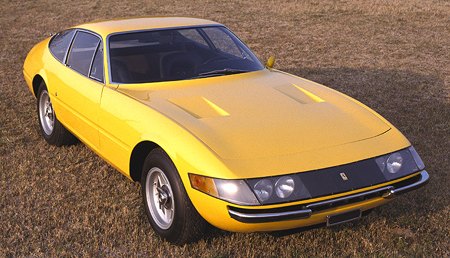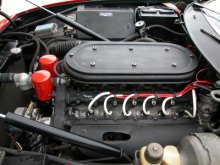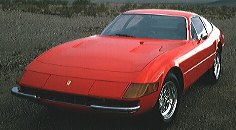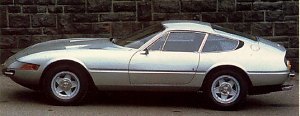Ferrari 365 GTB/4 Daytona (1969)
 If you ask which car was the greatest front-engined GT ever produced, many people will answer Ferrari 365GTB/4, nicknamed Daytona. Undoubtedly, Daytona had all the ingredients to justify this title: it looks sexy, it was the fastest car in the world and it delivered an excellent balance between handling and comfort. But most important of all, it was better than its arch-rival Lamborghini Miura in everyway ! Ferrari dominated the world's high-end sports car market during the whole 50s and the first half of 60s. However, in 1966 Lamborghini changed the scene completely by introducing Miura, a beautiful, state-of-the-art mid-engined supercar. It suddenly made Ferrari's flagship model 275GTB hopelessly outdated. To respond, Enzo Ferrari commissioned the development of the mid-engined Berlinetta Boxer, but the development could take too long. Therefore he also ordered to develop a stop-gap model based on the existing technology. That was the Daytona.  The Daytona was derived from its predecessor 275GTB. Its tubular steel chassis shared the same 2400mm wheelbase and the transaxle layout, i.e. gearbox mounted at the rear axle, for good balance. However, the chassis got wider to benefit handling and cabin space and was enclosed with a wind-cheating bodyshell to enhance top speed. It was styled by Pininfarina's design chief Leonardo Fioravanti, who also penned the Dino, BB and 308GTB. The design maestro gave Daytona a memorable shape – with slim nose, long bonnet and short tail, it looked like a great white shark. It brilliantly avoided the bulky shapes often seen in other front-engined grand tourers.  Ridiculously, the supposed "stop-gap" model would retain its title as the world's fastest supercar until the early 1980s, well beyond its life (it left the world in 1973). Its successor 365GT4/BB and 512BB failed to match its speed. Neither could the newer rival Lamborghini Miura SV, Maserati Bora and Lamborghini Countach of various kinds until 5000QV. The Daytona might be the last of its generation, but old wisdom was proved to be more effective than the spectacular-looking new generation mid-engined supercars. Perhaps because it was so fast, the new generation supercars were forced to claim wilder performance figures than they were capable of.  Daytona was not the best handling Ferrari at the time – that was the baby mid-engined Dino – but its handling still was very good. It had superb road-holding, good balance and a highly neutral cornering attitude. The unassisted steering was heavy but delivered plenty of feel. The firm ride was bearable and improved with speed. Compare with its mid-engined successors, its tail was much more difficult to be unsettled by power. Therefore the Daytona was easier to drive. The easy going manner spread to the cockpit. Thanks to the FR configuration, there was plenty of room for two and a generous boot. Besides, the additional luggage space behind the seats also were useful. No matter for performance, comfort or handling, the Daytona had far less compromises than the subsequent mid-engined supercars. No wonder Ferrari tried to resurrect its spirit with 550 Maranello in the mid-90s. However, in most people's mind 365GTB/4 Daytona still was the definitive front-engined GT.   |